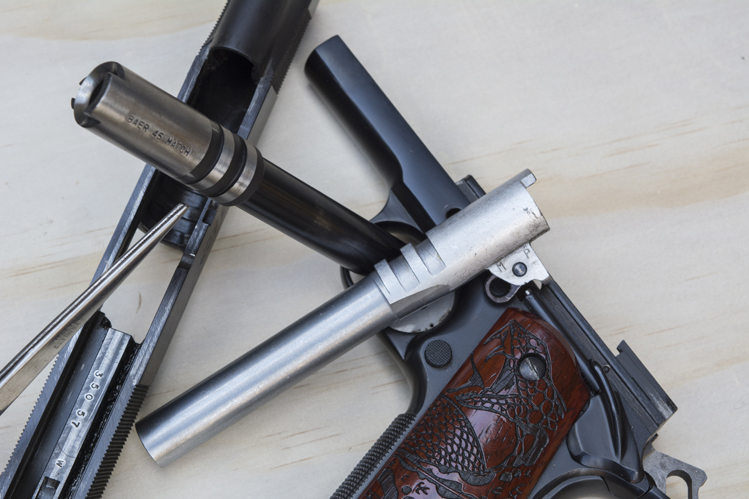
Let’s get this out of the way: if you don’t have at least some love in your heart for the 1911, you’re a godless commie heathen. Also you won’t find this entire series of articles very interesting, so we’re counting on you not even reading the first line, and then sending us hate mail. We get plenty already, mostly from godless commie heathens.
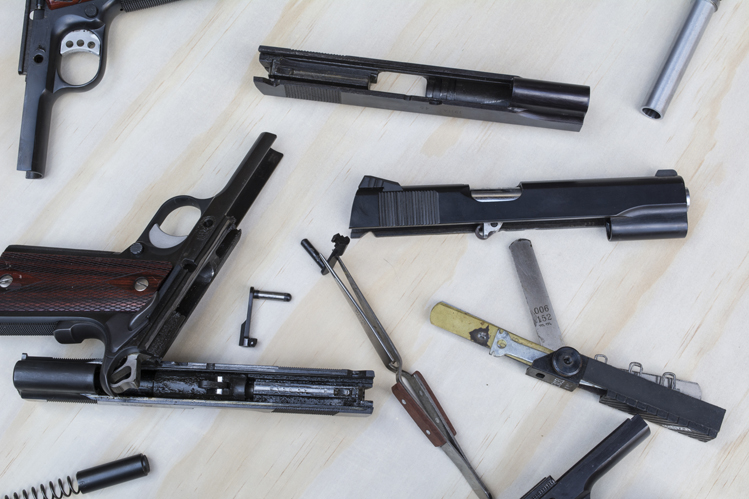 But if you’re like us, there’s something about the 1911 that warms your soul. Like hot rods and old war planes and carefully maintained motorcycles from an age before electronics ruled the earth, John Browning’s masterpiece reaches into the heart of a man, typically at something close to 900 feet per second, although overpressure loads are available (adjust spring rates accordingly.) Once there, it fragments into twin desires of nostalgic collection, and enthusiastic tinkering. Collections are highly risky to the wallet, but tinkering poses a risk not only to the wallet, but to the guns themselves.
But if you’re like us, there’s something about the 1911 that warms your soul. Like hot rods and old war planes and carefully maintained motorcycles from an age before electronics ruled the earth, John Browning’s masterpiece reaches into the heart of a man, typically at something close to 900 feet per second, although overpressure loads are available (adjust spring rates accordingly.) Once there, it fragments into twin desires of nostalgic collection, and enthusiastic tinkering. Collections are highly risky to the wallet, but tinkering poses a risk not only to the wallet, but to the guns themselves.
So let's get started on choosing your best 1911.
Have you your pistol? Have you your sharp-toothed files? No? Well, we, the restless tinkering people, we, the Walt Whitman alluding writers, we must choose wisely. The 1911 is a quirky beast, capable of great things if set up correctly but prone to difficulties if design parameters are ignored. The real difficulty is that an absolute sea of variations exist, not only on the pistol but on parts as seemingly interchangeable as the firing pin stop, and most are built by companies who have reverse-engineered their specs from unknown source material, then adjusted to get them working. Some of the companies taking this approach employ brilliant engineers driven by a love of the machine itself; others…don’t. Who builds according to the original plans? Colt can, if so they choose, because they have all the original drawings. And, in fact, Colt today builds the best 1911 pistols they’ve ever built, so if a Colt base gun is in your budget, that’s a good place to start. But if you’re squeamish about tearing into an unmolested Colt, have no fear: we have some advice.
Let’s assume you’re starting with a working pistol of some kind, rather than a frame and slide kit. Used or new, let’s begin by getting the best pistol available for the money.
Like anything else, some people will sell off a toy after it’s been abused to the point they don’t trust it. That’s unethical, but people are jerks. Big warning signs will include cracking at any 90 degree angle, frame or slide, so check the corners of the ejection port, the frame right where the rails end, and so on. Also check the rail above the slide stop cutout; these can crack from heavy use and overpressure loads.
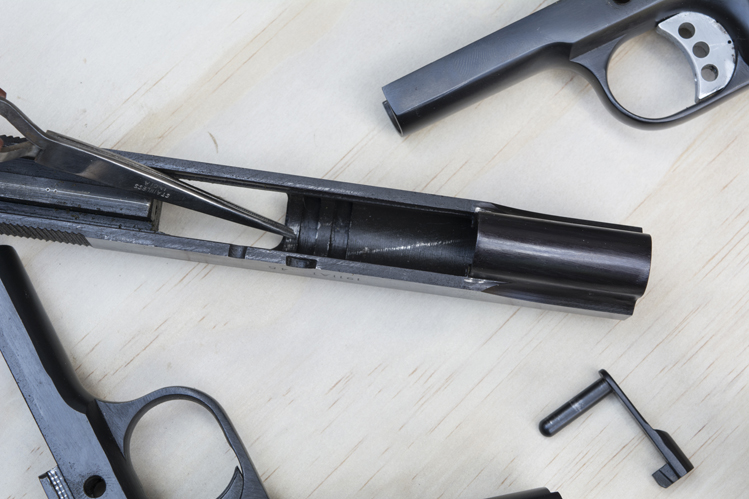
Inspection of the locking lugs on the slide is always a good way to check fit.
Look for peening or heavy wear on contact surfaces pertaining to the barrel. This tends to show up on the barrel hood or the slide where the barrel hood makes contact, on the barrel lugs either on the barrel itself or in the slide, or on the slide stop or barrel link. Smooth, even wear is nothing to worry about, but heavily lopsided wear or peening is bad news.
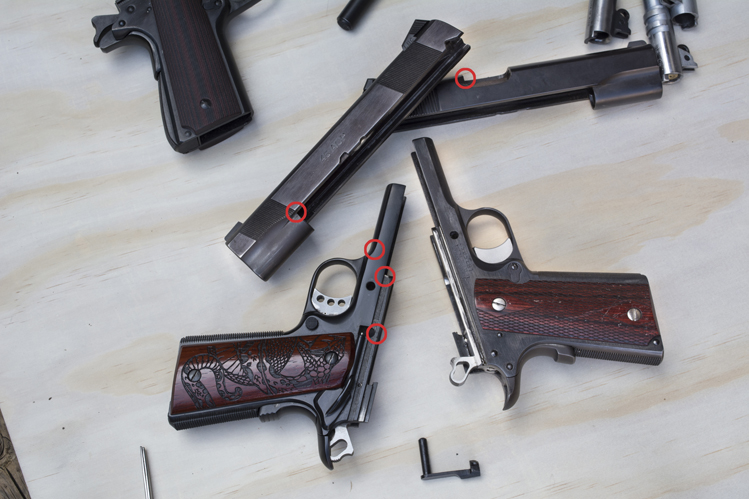
Check these areas for peening or cracking. Even wear is what you want to find.
Naturally, you’ll want to look out for corrosion, pitting, or rust. This shouldn’t need explanation, but it’s worth noting that rust is most commonly found under grip panels, which most sellers probably won’t let you see, but also inside the slide, which can be seen with a simple field strip.
Finally, be skeptical of any “custom” work. Be very careful about taking on someone else’s half-finished project. If it was easy to fix it and turn it into a working gun, they’d do it themselves.
Start by ensuring the gun is not loaded. If you screw this part up, nothing else in this article will be relevant, because you won’t be allowed to own guns anymore, so don’t screw this up. Next, point the gun in a safe direction, and consider that the above rule still applies. Now: test each safety feature.
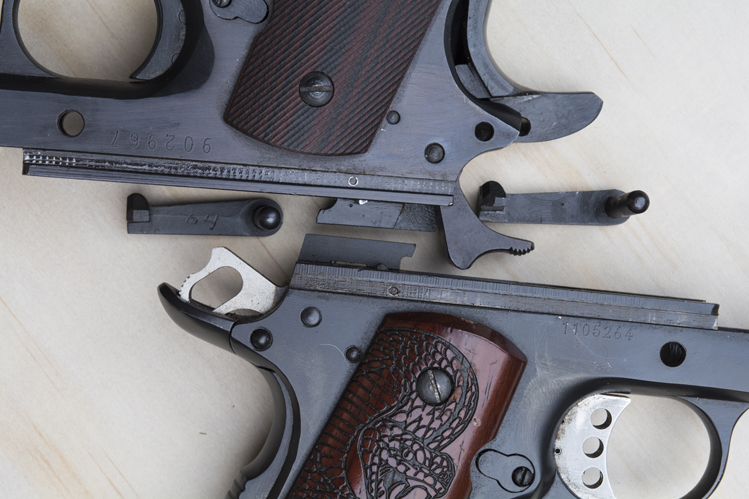
Visual inspection of some elements, like the rails, slide stop, and hammer can give a good indication of quality.
First, with thumb safety off, grip the pistol normally and press the trigger, holding it down. The hammer should fall, because this is the normal firing sequence. Next, while keeping the trigger pressed, rack the slide. The hammer should remain in the cocked position. If it falls when the slide is released, the gun has a condition known as “hammer follow” and is extremely dangerous so don’t walk, run. If the hammer remains cocked, release the trigger and press again. Now the hammer should fall.
Now pull the hammer slowly back to the first audible click. This is half-cock: on Series 70 pistols, the trigger should be inert. On Series 80 guns, the hammer will fall by design, but without enough force to ignite a primer. Series 80 triggers are specific to some Colt models although a similar system has been used in some SIG 1911s.
Next, rack the slide and apply the thumb safety. The hammer should not fall when trigger is pressed, or else the thumb safety is not doing its job. After testing the thumb safety, switch it off, and press the trigger again without depressing the grip safety. Again, this should prevent the hammer from falling.
Finally, to test the disconnector, cock the hammer and push the slide back out of battery approximately a quarter of an inch. The hammer should not fall when the trigger is pressed. If the gun passes the function tests, and it has no obvious damage or excessive wear, we can move on to the final stage: assessing quality.
A 1911’s heart is its trigger, and its soul is its barrel-to-slide lockup. It’s common to hear people obsess over frame-to-slide fitting, and it’s nice to have a good fit between the frame and the slide, certainly. But in terms of accuracy, the reliable, repeatable meshing of the part with the sights and the part with the bullet coming out of it is far more important. A decent trigger is relatively easy to discern: if it’s not gritty or heavy, and without a lot of play in any direction, with a firm and tactile reset, and you can’t get the hammer to dislodge without pressing the trigger, you can be fairly confident in it. But how do you measure barrel lockup?
The least invasive test is to press the hood of the barrel down, first with the gun fully in battery, then slightly out of battery. There should be no play in battery, and with the slide pulled a few millimetres back, only a tiny amount of play in any direction is acceptable. If the gun is used and the barrel to slide fit feels at all sloppy, it is very likely that the barrel link and lugs are significantly worn; this is a sign of serious problems.
One caveat: a tight barrel bushing can limit the effectiveness of this test, so beware pistols with the appearance of being well-used, which sport a brand new barrel bushing. Further investigation requires field stripping of the pistol, and boils down to the condition of the components mentioned above. In most cases, poor barrel to slide fit will have caused visible wear and peening on lug surfaces.
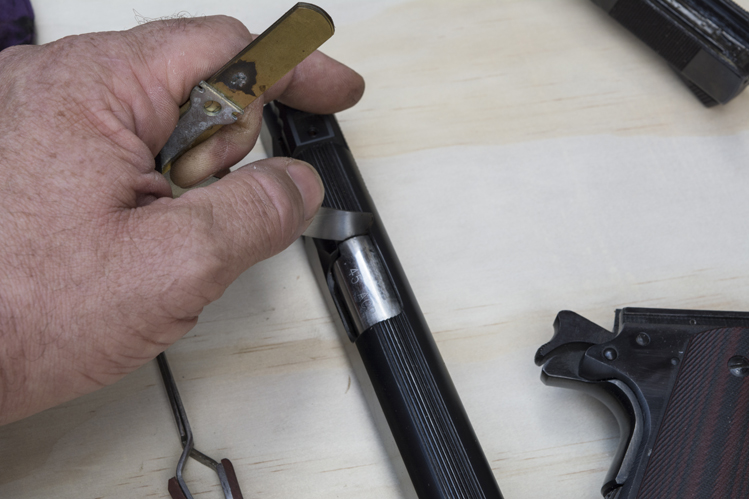
Look for no more than a few thousandths of an inch play between barrel hood and slide, with no recoil spring fitted.
If the gun can be reassembled without the recoil spring, end play in the barrel can also be checked; too much is again is a sign of sloppy barrel fitting. This can take some ingenuity to test since there is nothing to hang on to; sometimes the easiest way is to slip feeler gauges between the breechface and barrel hood. We’d recommend no more than a few thousandths of an inch clearance and even with the slide pulled back slightly, ten thou of end play would be about the most we’d accept. If your plan is to build a 1911 up from basic to the best 1911 you could ever imagine, including barrel replacement (which is no joke, believe us!) then a bit of extra space is not the end of the world provided the barrel lugs on the slide aren’t peened or otherwise deformed.
If you’ve gotten this far and you’re satisfied, congratulations: you’re well on your way to either the best 1911 for you that should run well with quality magazines, or to beginning a build that will scar your knuckles, test your patience, and prove your manhood. Welcome to the team!